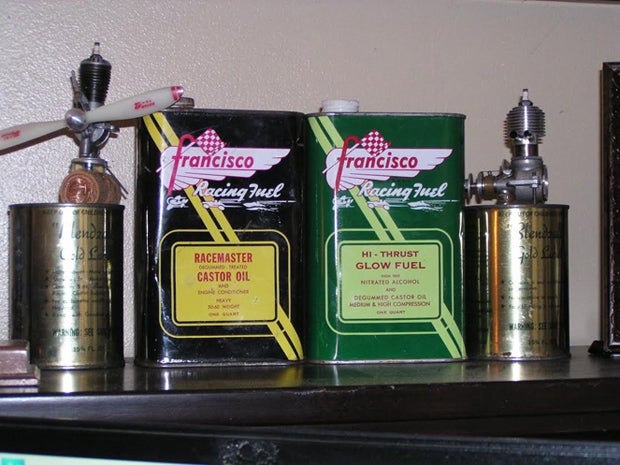
Castor bean oil has been around since the beginnings of the internal combustion engine. It is what was used in extreme racing environments when lubrication was a ďmust workĒ item. Bean oil had its definite pluses and a few minuses that kept you honest.
Letís take a look at the history of castor bean oil as a motor lubricant and see where it all began.
Back in the middle 1880s, the internal combustion engine was in its infancy. No real formula existed for what was right or wrong with respect to running or maintaining one, since it was such a new technology. All kinds of fuels and lubricants were used, everything from Benzene, to White Gas, along with vegetable (corn) oil to barely refracted high sulfur mineral oils. All these were used in the first internal combustion engines, and with limited success.
Eventually a couple of oil types were found to have an advantage over the others, that being the petroleum-based oils, and the oil derived from the castor bean.

In World War I, castor bean oil was used in Allied rotary aircraft engines such as the Gnome monosoupape (on a rotary the engine case and cylinders spin around a fixed crankshaft) because of its superior lubricating qualities, and much to the dismay of the pilots of the time, also a powerful laxative. One can imagine what slang terms resulted from that item alone.
Around 1905, The Society of Automobile Engineers was formed in the USA and took on the task of setting the standards for engine oil. They made the decision to compare and define lubricating oils by viscosity. Viscosity, in laymanís terms, is how easily a liquid pours.
The SAE decided to compare the viscosity of oils at 100 degrees centigrade, around the temperature of oil in a big end bearing - the most highly stressed part of an ordinary car engine. Viscosity decreases as temperature increases and at around 100°C, mineral oils start to become very thin and break down. Tests at this temperature are a useful oil strength indicator.
Viscosity is measured by the remarkably accurate method of pouring oil through a known size hole and measuring how long it takes to come out. The result of this is known as kinematic viscosity.
We could get into pages and pages of what the SAE found out in its tests, and the formulations on how viscosities got set, but weíre going to forgo all that crap and get back to bean oil, that mysterious stuff that smells so damn good.

Matt Cuddy recalls: "When I was a kid, a mere stripling of a 12 year old, I owned a mini-bike with a 50cc Fuji two-stroke motor. Because of Dirt Bike Magazine and their scientific test on two-stroke motor oils, I became hooked on bean oil. And since Francisco Labs was right around the corner on Hyperion Ave., I made my way there every few days to stock up on bean oil fortified with nitro, alcohol or any other additive that would give my mighty Go Devil the edge over the four-stroke, lawmower-powered mini bikes I had to compete against. It was a different age, where I purchased the Francisco Brown Label off Mrs. Francisco herself, and got to peek into the back room between the big swinging double doors that went to the lab.
Inside were giant stainless-steel refractors and god knew what else, all clean as an operating room, staffed by guys in white lab coats holding clip boards, busily staring into gauges and writing down temperatures and other data that a twelve year old could only imagine.
This small factory produced some of the BEST oils and fuels that any racer could ever ask for. I still have a half-full can of Francisco Brown Label that I treasure like a gold coin.
I went back to the lab a few days ago, and found much to my dismay that it is now a gay bar, with the entire lab section ripped out, the refractors and other equipment long gone to the junk man. I parked in the back, where the Francisco delivery trucks used to stay, and wheeled myself into the front office, now turned into a gaudy techno-bar filled with flashing strobe lights and strange sausage-shaped images all over everything. Mrs. Francisco was long gone, and so was I, as I wheeled myself out of that damn place as quick as humanly possible."
Back to the Castor bean oil. There are a couple types of bean oil, the first being bean oil that hasnít been processed to the point of losing its excellent lubrication properties. This type of bean oil is known as ďunfilteredĒ and has the dirty long-strand molecule base that makes this type of bean oil so superior at high temperatures. The more refined, cleaner burning stuff doesnít lubricate as well as the old dirty bean oil, or require the maintenance that running the dirty stuff does.
If you want to see for yourself the almost magical properties of castor bean oil, get a piece of flat steel, put a map gas torch underneath it, and get the metal almost red hot. Now put a drop of bean oil on the plate. The castor bean oil will actually move to the place on the steel thatís hottest and sit there. No sizzling, bubbling or steaming into nothingness. Amazing stuff.
Letís put it this way, if youíre in a race for big bucks, and youíre going to be screaming the guts out of your bike, hammering the motor to win, you want to be running bean oil, because it works better than anything else in the lubrication department. Period. Of course, it will eventually gum up the rings, put carbon deposits everywhere in the top end, and clog up the exhaust port, but if you want top lubrication at the expense of maintenance, it canít be beat.

Nowadays, in the world of complicated four-strokes that blow up like trick cigars, bean oil is a lost commodity, like buggy whips. But for old farts who remember the smell of Blenzall Gold, or Castrol R blowing out of the stinger of a CZ, it brings back memories that canít be forgotten. A simpler time when riders actually worked on their own machines and experimented with different fuel and oil combinations that allowed their bikes to live, and win. Castor bean oil is part of that history.
More from Matt: "I have an almost full bottle of Castrol R that I run in my weed whacker. And if I close my eyes and take a good whiff off the exhaust, Iím back at Indian Dunes on my Bultaco, out in the Santa Clarita wash splashing through the river and having one damn good time. Thatís the bean oil, thatís what it does to you.
Bean Oil Update: I own a Colt .380 Automatic that's about 100 years old now, and it's got a little surface rust, some pitting and browning on the back-strap safety. So for the heck of it, I took a clean rag, dabbed some Francisco Bean Oil on it, and wiped the pistol down.
The next day I looked at the old .380 Hammerless automatic, and I'll be damned if the pistol doesn't look like new, all the pits and rust have disappeared, the brown has turned to blue again, and, well, I'll be using bean oil as a surface oil from here on out on my rifles and pistols."
The bottom line is this: all the new oils out there, especially synthetics, run very, very clean. However, you want the absolute in protection in a radical engine under radical circumstances, nothing is better than bean oil. Sure, it's dirty and you pay a heavy price in maintenance, but nothing works as well as it does.


 Your Privacy Choices
Your Privacy Choices